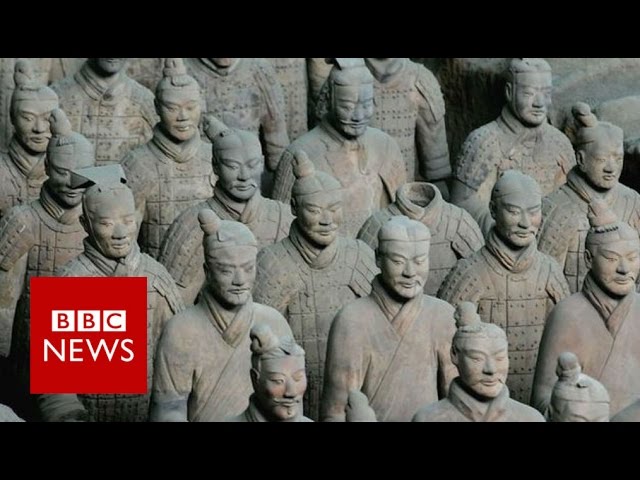The original terracotta army is a collection of terracotta sculptures depicting the armies of Qin Shi Huang, the first Emperor of China. It is a form of funerary art buried with the emperor in 210–209 BCE and whose purpose was to protect the emperor in his afterlife. The figures, dating from approximately the late third century BCE, were discovered in 1974 by local farmers in Lintong District, Xi’an, Shaanxi province. The figures vary in height according to their roles, with the tallest being the generals. The figures include warriors, chariots, horses, officials, acrobats, strongmen, and musicians. Current estimates are that in the three pits containing the Terracotta Army there were over 8,000 soldiers, 130 chariots with 520 horses and 150 cavalry horses, the majority of which are still buried in the pits.
History of the terracotta army
The terracotta army was commissioned by Qin Shi Huang, the first Emperor of China, to serve as an afterlife guard to protect him in his mausoleum. He began construction of his mausoleum shortly after ascending the throne, and it became one of the grandest projects of the dynasty. The terracotta army was created to serve as a guard to the emperor in the afterlife, and it is believed that the figures were carefully sculpted in the likeness of the emperor’s army. The terracotta figures were manufactured in workshops by government laborers and local craftsmen using local materials. The terracotta figures were assembled in sections, then placed in the pits in precise military formation according to rank and duty. The figures were then buried with the emperor in 210–209 BCE.
Discovering the terracotta army
The terracotta army was discovered in 1974 by local farmers in Lintong District, Xi’an, Shaanxi province. The farmers had been digging a well when they stumbled upon one of the figures. They reported the find to the authorities, who then sent a team of archaeologists to investigate. The team was amazed to find thousands of life-sized terracotta figures, arranged in battle formation. The terracotta army was found in three pits located around the mausoleum of Qin Shi Huang. The three pits cover an area of 22,780 square meters (245,000 square feet).
Features of the terracotta army
The terracotta army is a remarkable example of ancient Chinese art. The figures vary in height according to their roles, with the tallest being the generals. The figures include warriors, chariots, horses, officials, acrobats, strongmen, and musicians. The figures are all life-sized and are remarkably detailed. Each figure has unique facial features, clothing, and hairstyles. The figures are painted with vibrant colors and show a high level of craftsmanship.
The weapons of the terracotta army
The terracotta figures are armed with a variety of weapons, including swords, spears, crossbows, and battle-axes. The weapons were made of bronze, which was the preferred metal for weapons at the time. The weapons were also highly detailed and showed a high level of craftsmanship. The weapons were believed to be functional and could have been used in battle if necessary.
Significance of the terracotta army
The terracotta army is a remarkable example of ancient Chinese art and technology. The figures are an important reminder of the power and sophistication of the Qin dynasty. The terracotta army also serves as an important reminder of the importance of burial and afterlife rituals in ancient China. The figures have become a symbol of China’s long and rich history, and are an important part of the country’s cultural heritage.
The terracotta army today
Today, the terracotta army is one of China’s most popular tourist attractions. The figures are housed in a museum near the mausoleum of Qin Shi Huang, and the site is visited by millions of tourists each year. The terracotta army is also a UNESCO World Heritage Site, and is listed as one of the world’s most important cultural sites.
Conclusion
The terracotta army is a remarkable example of ancient Chinese art and technology. The figures are an important reminder of the power and sophistication of the Qin dynasty, and are a symbol of China’s long and rich history. The terracotta army is now one of China’s most popular tourist attractions, and a UNESCO World Heritage Site. It is an important part of the country’s cultural heritage, and a testament to the skill and creativity of the ancient Chinese.


0 Comments